Mark James E. (ed.). Physical Properties of Polymers Handbook
Подождите немного. Документ загружается.

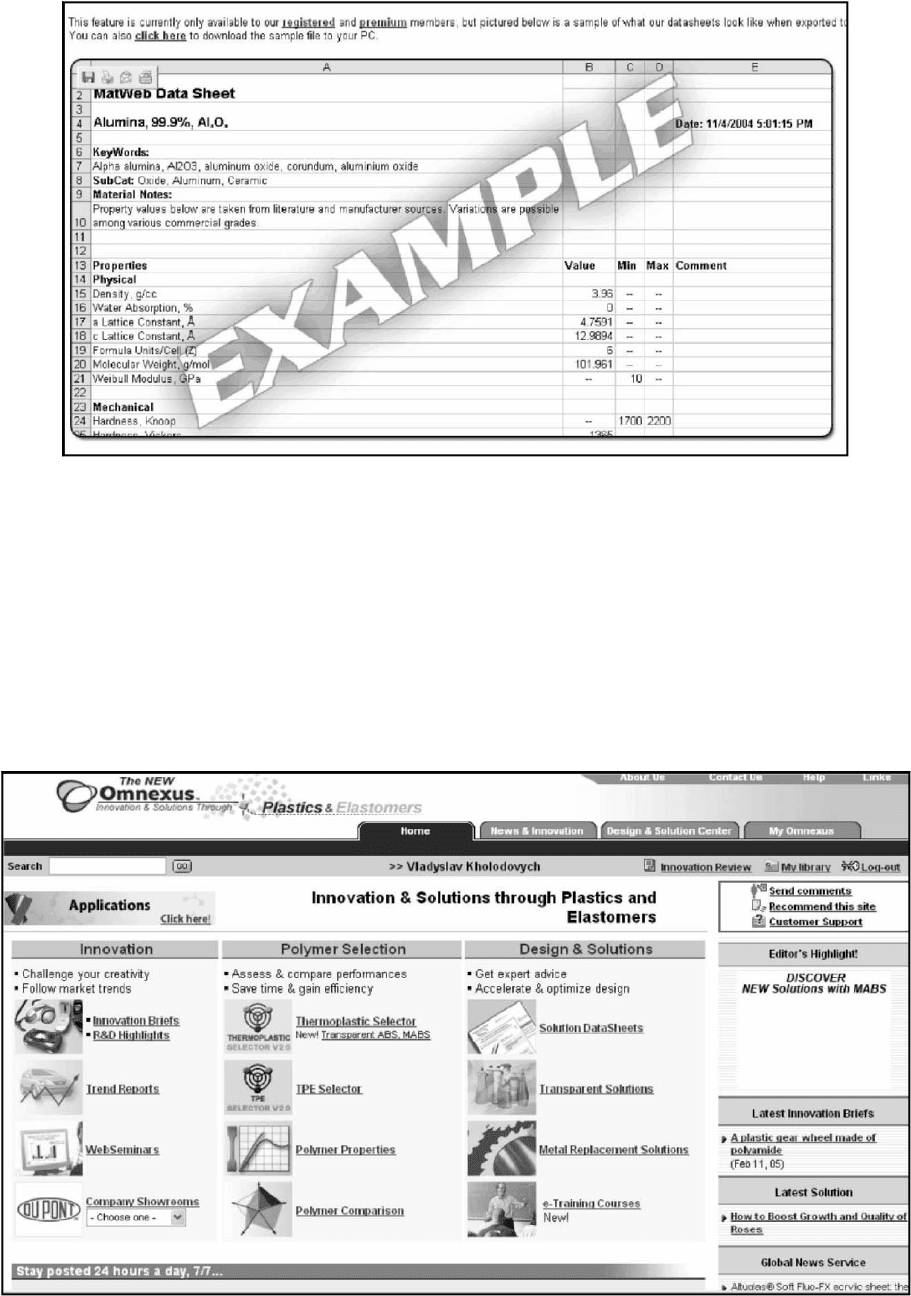
MatWeb, http://www.matweb.com, is a searchable data-
base of over 46,000 metals, plastics, ceramics, and compos-
ite materials. It allows search by material type, trade name,
range of values, composition, UNS number (Unified Num-
bering System for Metals and Alloys) and even system of
units (metric, common US units). An example of searchable
materials includes thermoplastic and thermoset polymers
such as ABS, nylon, polycarbonate, polyester, polyethylene,
and polypropylene; metals such as aluminum, cobalt, cop-
per, lead, magnesium, nickel, steel, superalloys, titanium,
and zinc alloys; ceramics; plus semiconductors, fibers, and
other engineering materials.
For registered users, all data retrieved from searches can
be exported to an Excel spreadsheet for further analysis (Fig.
54.4, 54.5).
Another web resource, Omnexus can be found at the
following address: http://www.omnexus.com/index.aspx
(Fig. 54.6).
FIGURE 54.5. Example of the Excel spreadsheet generated after MatWeb search. Reprinted with permission ß (1996–2006) by
Automation Creations, Inc.
FIGURE 54.6. A screenshot taken of the front page of the Omnexus website. Reprinted with permission from Omnexus.com.
THERMAL-OXIDATIVE STABILITY AND DEGRADATION OF POLYMERS / 937
This site contains very useful information, such as current
news in polymer science, information about on-line sem-
inars and scientific conferences, and numerous material
databases. Databases are searchable by various criteria,
such as physical and chemical properties, molecular weight
or density. The search output also contains information
about manufacturer and on-line vendors. This site requires
registration for full access, but registration is free.
REFERENCES
1. L. D. Loan and F. H. Winslow, in Macromolecules: An Introduction to
Polymer Science, edited by F. A. Bovey and F. H. Winslow, (Elsevier
Science & Technology, Amsterdam, 1982) p. 576.
2. N. Grassie and G. Scott, Polymer Degradation & Stabilisation
(Cambridge University Press, Cambridge, 1988) p. 222.
3. L. Reich and S. S. Stivala, Elements of Polymer Degradation,
(McGraw-Hill Book Company, New York, 1971) p. 361.
4. N. Grassie, in Encyclopedia of Polymer Science and Technology,
vol.4, (Interscience Publishers, New York, 1966) p. 647.
5. L. I. Nass, in Encyclopedia of Polymer Science and Technology,
vol.12, (Interscience Publishers, New York, 1966) p. 725.
6. J. E. Mulvaney, in Encyclopedia of Polymer Science and Technology,
vol. 7, (Interscience Publishers, New York, 1966) p. 478.
7. R. B. Seymour and C. E. Carraher, Jr., Structure-Property Relation-
ships in Polymers, (Plenum Press, New York, 1984) p. 246.
8. C. Hall, Polymer Materials, (Halsted Press: John Wiley & Sons,
New York, 1989) p. 243.
9. H. R. Allcock and F. W. Lampe, Contemporary Polymer Chemistry,
third edition, (Prentice-Hall, Inc., Upper Saddle River, NJ, 2003)
p. 832.
10. H.-G. Elias, Macromolecules, second edition, (Plenum Press,
New York, 1984), p. 564.
11. F. W. Billmeyer, Jr., Textbook of Polymer Science, third edition
(Wiley-Interscience: John Wiley & Sons, New York, 1990) p. 578.
12. D. W. van Krevelen, Properties of Polymers: Their Correlation with
Chemical Structure: Their Numerical Estimation and Prediction from
Additive Group Contributions, third edition, (Elsevier Scientific,
Amsterdam, 1997), p. 875.
13. C. Arnold, Jr., J. Polym. Sci.: Macromolecular Rev. 14, 265
(1979).
14. W. J. Welsh, D. Bhaumik, H. H. Jaffe, et al. Polym. Eng. Sci. 24, 218
(1984).
15. R. C. Evers and G. J. Moore, J. Polym. Sci.: Part A: Polym. Chem. 24,
1863 (1986).
16. W. J. Welsh, in Current Topics in Polymer Science, vol. I, edited by
R.M. Ottenbrite, L. A. Utracki, and S. Inoue, (Hanser Publishers,
Munich, 1987) p. 217.
17. F. E. Arnold and R. L. Van Deusen, Macromolecules, 2, 497 (1969);
R.L. Van Deusen, O. K. Goins, and A. J. Sicree, J. Polym. Sci. A-l, 6,
1777 (1968).
18. W. J. Welsh, D. Bhaumik, and J. E. Mark, J. Macromol. Sci. Phys. 20,
59 (1981).
19. W. J. Welsh and J. E. Mark, in Computational Modeling of Polymers,
edited by J. Bicerano, (Marcel Dekker, Inc., New York, 1992)
p. 648.
20. R. D. Miller and J. Michl, Chem. Rev. 89, 1359 (1989).
21. N. Grassie, in the Polymer Handbook, fourth ed., edited by J. Brandrup
(Editor), Edmund H. Immergut, Eric A. Grulke, Akihiro Abe,
Daniel R. Bloch, (Wiley-Interscience: John Wiley & Sons, New York,
2003) p. 2336.
22. J. H. Noggle, Physical Chemistry, third ed., (Pearson Education,
New York, 2002), p. 1108.
23. B. E. Douglas, D. H. McDaniel, and J. J. Alexander, Inorganic Chem-
istry, 2nd ed., (John Wiley & Sons, Inc., New York, 1993) p. 78.
938 / CHAPTER 54

CHAPTER 55
Synthetic Biodegradable Polymers
for Medical Applications
Laura J. Suggs*, Sheila A. Moore
y
, and Antonios G. Mikos
y
*Department Biomedical Engineering, University of Texas at Austin, Austin, TX 78712
y
Department of Bioengineering, Rice University, PO Box 1892, MS-142, Houston, TX 77251-1892
55.1 Introduction . ............................................................. 939
55.2 Biodegradable Polymers . . . ................................................ 939
55.3 Summary . . . ............................................................. 947
55.4 Acknowledgments ........................................................ 947
55.5 Appendix . . . ............................................................. 947
56.6 Chemical Structures ....................................................... 948
References . . ............................................................. 949
55.1 INTRODUCTION
Biodegradability has been the primary consideration in
the development of biomedical materials due to problems
associated with the biocompatibility of long-term, nonde-
gradable polymer implants. Biodegradable polymers have
been formulated for uses such as sutures, drug delivery
devices, scaffolds for tissue regeneration, vascular grafts
and stents, artificial skin, orthopedic implants, and others.
The purpose of this overview is to elucidate the character-
istics of several synthetic biodegradable polymers for med-
ical applications, which include degradation modes and
rates and their relationship to physicochemical, thermal,
and mechanical properties. Polymers mentioned in the chap-
ter are poly (a-hydroxy esters), poly(e-caprolactone), poly
(ortho esters), polyanhydrides, poly(3-hydroxybutyrate)
polyphosphazenes, polydioxanones, fumarate-based poly-
mer, polyoxalates, poly(amino acids), and pseudopoly
(amino acids). The synthesis, medical uses, and processing
techniques of these polymers are not discussed in detail, but
additional references are given for each polymer as well as
several comprehensive review articles [1–8].
55.2 BIODEGRADABLE POLYMERS
55.2.1 Poly(a-Hydroxy Esters)
Poly(Glycolic Acid)
Poly(glycolic acid) (PGA) is a highly crystalline, hydro-
philic, linear aliphatic polyester (Structure 1). As such, it has
a high melting point and a relatively low solubility in most
common organic solvents. At room temperature, PGA is
soluble in hexafluoroisopropanol, a highly toxic solvent. It
degrades primarily by bulk erosion through random hy-
drolysis of its ester bonds. Reed and Gilding [9] report that
the degradation kinetics is biphasic, with the first phase of
degradation occurring by diffusion of water to the amorph-
ous regions and subsequent hydrolysis. The second phase
begins as water penetrates and hydrolyzes the more crystal-
line regions. The molecular weight distributions, which
show two degradation phases, are given in Fig. 55.1 [9].
For PGA surgical sutures, mass loss occurs primarily during
the second phase, completing the entire process between
weeks 4 and 12. The rate of hydrolysis can be controlled
939
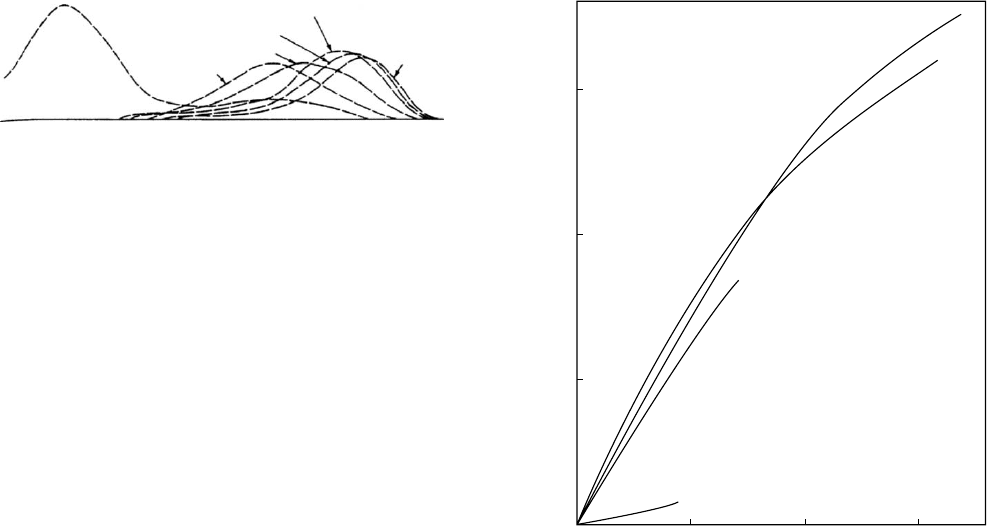
in vitro by varying the pH [10]. Any large deviation from
neutral pH drives hydrolytic cleavage. In addition, the deg-
radation rate can be affected by the degree of crystallinity or
‘‘curing time’’ of PGA, as shown in in vivo studies [11].
The crystallinity of PGA is typically between 46% and
52% [9], the maximum crystallinity during degradation
occurring in the time between the two degradation phases.
The values of crystallinity are not only influenced by the
quenching or ‘‘curing’’ process but also the molecular
weight of the polymer [12].
PGA (crystallinity 50%) loses most of its mechanical
strength over the first 2–4 weeks of degradation [9]. This
is asynchronous with the mass loss which begins at approxi-
mately week 4. This is due to the bimodal degradation
distribution. The amorphous regions are hydrolyzed first
which results in loss of mechanical strength, while the
degradation and diffusion of low molecular weight chains
later result in significant mass loss. The stress/strain curves
showing the effect of degradation on mechanical strength
are given in Fig. 55.2 [9].
Poly(Lactic Acid)
Poly(lactic acid) (PLA) (Structure 2) is also a linear
polyester, but the presence of an extra methyl group makes
it more hydrophobic than PGA. Its water uptake in thin films
is approximately 2% [13]. The methyl group contributes to a
more amorphous character as well as increasing its solubil-
ity in organic solvents. In addition, this group creates a
chiral center which results in two different enantiomeric
forms of the polymer, P(D)LA and P(L)LA. The racemic
mixture of the two is abbreviated as P(D,L)LA. The most
commonly used form is P(L)LA which, like all poly(lactic
acids), releases lactic acid upon degradation. PLA is fre-
quently cast from common solvents. These include: chloro-
form, methylene chloride, methanol, ethanol, benzene,
acetone, dioxane, dimethylformamide, and tetrahydrofuran
[14–16]. PLA has also been shown to degrade by a homo-
geneous, hydrolytic erosion [17–19]. For example,
P(D,L)LA degrades in a conventional two-stage process
where the majority of molecular weight loss occurs in the
first stage, and the subsequent loss in mass and tensile
strength begins in the second stage at a number average
molecular weight of 15,000 [9]. P(L)LA of molecular
weight 95,000 degraded in vivo by 56% in 6 months based
on peak molecular weight (M
p
) [20]. For P(D,L)LA between
58,000 and 87,000, 49% degraded in vivo in 1 month, also
based on M
p
. A half-life of 6.6 months by mass was reported
[11] for P(L)LA of molecular weight 85,000. In vitro studies
[9] showed a 50% loss in weight average molecular weight
(M
w
) in 16 weeks with a concurrent loss of 10–15% by
mass. The degradation rate of PLA also varies with varying
pH [21,22]. The amount of lactic acid released during the
course of PLA degradation is very small but increases rap-
idly as PLA is broken down to low molecular weight oligo-
mers. A sudden rise in the lactic acid concentration in vivo
can render the local environment acidic and induce an
inflammatory reaction or even tissue necrosis. The use of
polydispersed PLA can result in distribution of the lactic
acid production over time [23].
Thermal and mechanical properties of both P(L)LA and
P(D,L)LA of various molecular weights are given in Table
55.1. Additional thermal properties of PLA are found in Lu
et al. [24].
Poly(Lactic-co-Glycolic Acid) Copolymers
The advantage of copolymerizing poly(a-hydroxy esters)
is the ability to control physical and mechanical properties;
56 days
28 days
Low MW High MW
21 days
7 days
14 days
0 days
FIGURE 55.1. Molecular weight distributions as a function of
degradation time for PGA sutures at pH 7 and 37 8C. The
formation of a bimodal distribution is evident at large times
due to the biphasic degradation of PGA. (Reprinted with
permission from [9].)
010
0.5
1.0
1.5
20
'6' weeks
% elongation
'4' weeks
k
gm
−2
(x 10
−7
)
'2' weeks
'0' weeks
30
FIGURE 55.2. Stress/strain curves showing the loss of
mechanical strength with degradation time for PGA sutures
at pH 7 and 37 8C. (Reprinted with permission from [9].)
940 / CHAPTER 55

however, there is no linear relationship between the physical
properties of the constituent homopolymers and their co-
polymers. Most of these copolymers are amorphous (be-
tween approximately 24 and 67 mol% glycolic acid) [13],
and therefore, degradation rates are highly dependent on the
relative amount of each comonomer. Copolymers with high
or low comonomer ratios are less sensitive to hydrolysis
than copolymers with a more equimolar ratio, due to their
greater crystallinity. Half-lives for various PLA and PGA
ratios are depicted graphically in Fig. 55.3 [11].
TABLE 55.1. Thermal and mechanical properties of respective synthetic biodegradable polymers [4,24,48,74,75,95,96].
Polymer
Weight
average
molecular
weight
Glass
transition
temp.
(8C)
Melting
temp.
a
(8C)
Decompo-
sition
temp.
(8C)
Heat of
fusion
a
(Jg
1
)
Tensile
strength
(MPa)
Tensile
modulus
(MPa)
Flexural
modulus
(MPa)
Elongation
at yield
(%)
Elongation
at break
(%)
Poly(a-Hydroxy Ester)
PLGA 50,000 35 210 254 71 — — — — —
P(L)LA 50,000 54 170 242 41 28 1,200 1,400 3.7 6
P(L)LA 100,000 58 159 235 20 50 2,700 3,000 2.6 3.3
P(L)LA 300,000 59 178 255 39 48 3,000 3,250 1.8 2
P(D,L)LA 21,000 50 A 255 A — — — — —
P(D,L)LA 107,000 51 A 254 A 29 1,900 1,950 4.0 6
P(D,L)LA 550,000 53 A 255 A 35 2,400 2,350 3.5 5
Poly(e-Caprolactone) 44,000 62 57 350 34 16 400 500 7.0 80
Poly(Ortho Esters)
P(CDM-co-HD) 35:65 99,700 55 A 358 A 20 820 950 4.1 220
P(CDM-co-HD) 70:30 101,000 84 A 362 A 19 800 1,000 4.1 180
P(CDM-co-HD) 90:10 131,000 95 A 338 A 27 1,150 1,250 3.4 7
Polyanhydrides
PSA — 60 86 — 153 — — — — —
P(CPP-co-SA) 22:78 — 47 66 — 64 — — — — —
P(CPP-co-SA) 41:59 — 4 178 — 8 — — — — —
P(CPP-co-SA) 60:40 — 0 200 — 25 — — — — —
P(CPP-co-SA) 80:20 — 15 205 — 34 — — — — —
PCPP — 96 240 — 111 — — — — —
Poly(3-Hydroxybutyrates) Copolymers
PHB 370,000 1 171 252 51 36 2,500 2,850 2.2 2.5
P(HB-co-HV) 93:7 450,000 1 160 243 32 24 1,400 1,600 2.3 2.8
P(HB-co-HV) 89:11 529,000 2 145 235 12 20 1,100 1,300 5.5 17
P(HB-co-HV) 78:22 227,000 5 137 251 7 16 620 750 8.5 36
Polydioxanones
PTMC 48,000 15 A 261 A 0.5 3 — 20 160
Pseudopoly(Amino Acids)
PBPA 105,000 69 A 135 A 50 2,150 2,400 3.5 4
PDTH 101,000 55 A 138 A 40 1,630 — 3.5 7
Poly(Fumarates)
PPF:PPF-DA 1:2
b
2,600 11.2 A — A 61 857 3,124 5.6 10.8
PPF:PPF-DA 1:1 2,600 11.2 A — A 70 923 2,644 4.3 11.3
PPF:PPF-DA 2:1 2,600 11.2 A — A 64 806 2,206 4.3 12.9
P(PF-co-EG)
c
33:66 8,200 54.1 26.5 — 17.5 0.23 2.16 0.87 — —
P(PF-co-EG) 33:66 14,200 44.6 39.7 — 20.1 0.32 1.9 3.87 — —
P(PF-co-EG) 66:33 8,050 43.5 25.0 — 0.2 1.06 11.02 1.69 — —
P(PF-co-EG) 66:33 13,090 46.1 27.7 — 9.9 0.91 5.05 2.39 — —
a
The symbol A designates amorphous polymer.
b
PPF:PPF-DA 1:2 refers to the ratio of double bonds present in each monomer.
c
P(PF-co-EG) was crosslinked with poly(N-vinyl pyrrolidinone).
SYNTHETIC BIODEGRADABLE POLYMERS FOR MEDICAL APPLICATIONS / 941
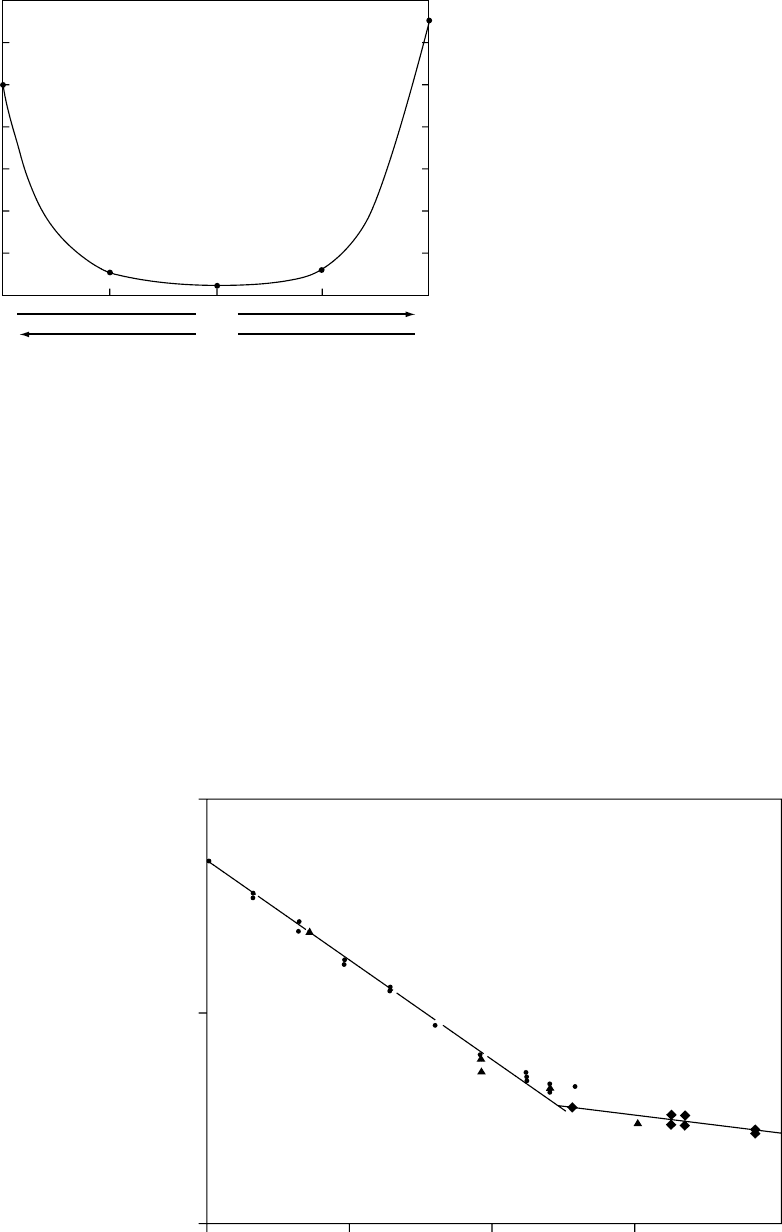
Due to the dependence of the degradation rate of poly
(lactic-co-glycolic acid) (PLGA) copolymers on pH, a phe-
nomenon known as autocatalysis occurs where the carboxylic
acid monomers released during degradation reduce the pH
and further induce degradation [22–25]. For large-scale poly-
mers, autocatalysis causes a heterogeneous degradation
where the pH decreases in the center of the polymer, and a
differential in the degradation rate is created [26].
Multiple uses of poly(lactic acid), poly(glycolic acid),
and their copolymers have been described including sutures
[27], vascular grafts [28], drug carriers [29,30], and scaf-
folds for tissue engineering [31,32]. This is due in part to
the FDA approval of these polymers for certain medical
applications.
55.2.2 Poly(«-Caprolactone)
Poly(e-caprolactone) (PCL) is a semicrystalline, aliphatic
polyester (Structure 3). It is soluble intetrahydrofuran,chloro-
form, methylene chloride, carbon tetrachloride, benzene,
toluene, cyclohexanone dihydropyran, and 2-nitropropane;
and only partially soluble in acetone, 2-butanone, ethyl acet-
ate, acetonitrile, and dimethyl fumarate [33]. PCL is also
capable of forming blends as well as useful copolymers with
a wide range of polymers [34].
PCL has been shown to degrade by random hydrolytic
scission of its ester groups, and under certain circumstances,
by enzymatic degradation [33]. It is similar to P(D,L)LA, in
that it degrades in a two-phase process with the molecular
weight loss occurring primarily in the first phase, and the
major mass and strength loss at the onset of the second at a
number average molecular weight of 5,000 [35]. However,
PCL degrades almost three times slower than P(D,L)LA [4].
A graph of molecular weight versus time showing the deg-
radation of PCL capsules in vivo is given in Fig. 55.4 [35].
The crystallinity of PCL increases with decreasing molecular
weight with polymers of molecular weight above 100,000
being about 40% crystalline. This value increases to about
80% for molecular weights of 5,000 [35]. As a result, PCL
behaves like PGA in that the residual crystallinity increases
0
100
PLA
PGA
copolymer ratio
1
1/2
months
0
100
0
2
4
6
FIGURE 55.3. Variation of half-life of PLGA copolymers with
the lactic acid and glycolic acid copolymer ratio in vivo. (Rep-
rinted with permission from [11].)
50
10
3
10
4
10
5
100
TIME (WEEKS)
MOLECULAR WEIGHT (M
n
)
150
FIGURE 55.4. Decrease of molecular weight of PCL with the degradation time for PCL capsules loaded with various drugs in vivo.
(Reprinted with permission from [35].)
942 / CHAPTER 55
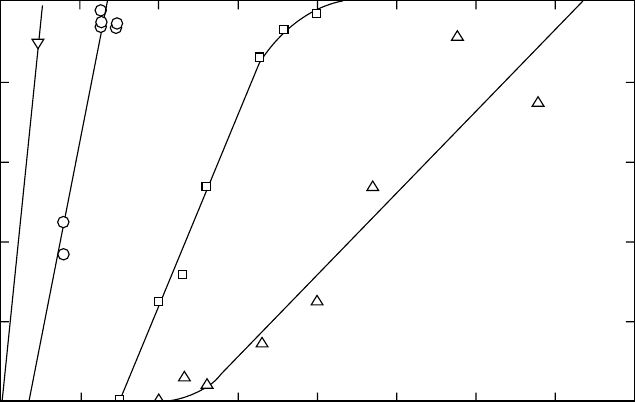
as the polymer degrades. The degradation rate of PCL can be
increased by forming a copolymer with DL-lactide [36]. In
addition, PCL is affected by acidic conditions consistent
with an autocatalytic degradation mechanism, and it is also
influenced by the addition of small molecules such as etha-
nol, pentanol, oleic acid, decylamine, and tributyiamine [37].
PCL has a low glass transition temperature of 62 8C,
existing always in a rubbery state at room temperature, and a
melting temperature of 57 8C. It has been postulated that
these properties lead to a high permeability of PCL for
controlled release agents. Other thermal and mechanical
properties are listed in Table 55.1.
55.2.3 Poly(Ortho Esters)
Poly(ortho esters) are amorphous, hydrophobic polymers
containing hydrolytically labile, acid-sensitive, backbone
linkages (Structures 4, 5, 6). Due to their hydrophobicity,
they can easily dissolve in organic solvents including: chloro-
form, methylene chloride, and dioxane. However, it can be
difficult to remove the solvent in a situation such as a solvent
casting [38]. In addition, these polymers are not inherently
susceptible to degradation in the presence of water, although
they can be if anhydrides (acid excipients), glycolic acid, or
lactic acid are incorporated. They are susceptible to thermal
degradation and must be processed accordingly.
Poly(ortho esters) are a class of polymers which can
degrade heterogeneously by surface erosion [39]. These
polymers lose material from the surface only, while retain-
ing their original geometry. As such, their primary use is in
drug delivery [40]. The first class of poly(ortho esters), as
shown in Structure 4, generates a carboxylic acid upon
hydrolysis which then further catalyzes the acid-sensitive
cleavage. A basic salt such as Na
2
CO
3
or Mg(OH)
2
is
usually incorporated to neutralize the acid product, how-
ever, this creates a diffusion-limited system which exhibits
nonzero-order drug release characteristics.
The second class, represented by Structures 5 and 6, does
not produce acidic hydrolysis products, and its degradation
can be controlled by the incorporation of either acidic
or basic excipients. In the case of acid addition, water
penetrates, ionizes the acid, and reduces the pH. This then
catalyzes the hydrolysis, resulting in a hydration front
and an erosion front. For a basic excipient, water must
penetrate, elute, or neutralize the base, and then allow
erosion to occur, decreasing the rate of hydrolysis [41].
According to the choice of additive, degradation rates can
be varied from several days to years. Acid excipients can
also be incorporated into the polymer itself as pendant
chains which are solubilized upon cleavage [42]. For ex-
ample, the degradation rates are enhanced for polymers
containing trans-cyclohexanedimethanol (CDM) and 1,6-
hexanediol (HD) when acidic functionalities, 9,10-dihy-
droxy-stearic acid (DHSA) [43], are incorporated, as
shown in Fig. 55.5. The polymer can also be crosslinked at
temperatures as low as 40 8C with an excipient stabilized
interior [44].
0
0
10
20
40
60
80
100
20 30 40
TIME - DAYS
WEIGHT LOSS - PERCENT
50 60 70 80
FIGURE 55.5. Variation of cumulative weight loss with time for poly(ortho esters) containing trans-cyclohexanedimethanol
(CDM), 1,6-hexanediol (HD), and 9,10-dihydroxy-stearic acid (DHSA) (in the form of 6 0.5 mm disks at pH 7 and 37 8C). S ¼
58% CDM, 38% HD, 4% DHSA; E ¼ 59% CDM, 39% HD, 2% DHSA; G ¼ 59.5% CDM, 39.5% HD, 1% DHSA; C ¼ 59.7% CDM,
39.75% HD, 0.5% DHSA. (Reprinted with permission from J. Heller, D. W. H. Penhale, and S. Y. Ng. in Long-Acting Contraceptive
Delivery Systems, edited by G. I. Zatuchni, A. Goldsmith, J. D. Shelton, and J. J. Sciarra, (Harper and Row, New York, 1984),
p. 127.)
SYNTHETIC BIODEGRADABLE POLYMERS FOR MEDICAL APPLICATIONS / 943
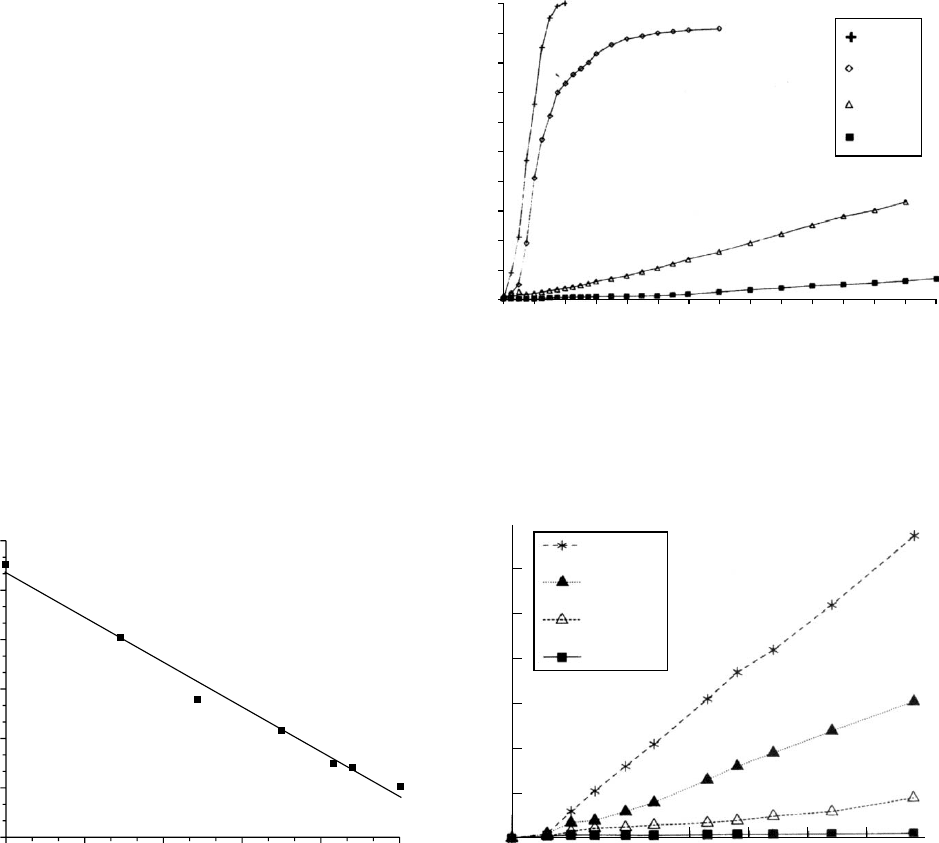
Functionalizing the third class with lactic acid or glycolic
acid produces an autocatalytic polymer [45,46]. Degrad-
ation is mediated by surface and bulk erosion, which is
controlled by the concentration of the a-hydroxy acid seg-
ments [47]. There is a linear relationship between weight
loss and lactic acid release suggesting surface erosion, also
molecular weight decreases signifying bulk erosion. Unlike
PLGA and PLA the bulk of the material does not become
acidic; the acid products from hydrolysis are concentrated at
the surfaces and are easily diffused away [47].
The mechanical and thermal properties of these polymers
can also be varied over a wide range by the selection of
starting materials with differing compositions and molecu-
lar weights. The tripolymerization of 3,9-bis(ethylidene
2,4,8,10-tetraoxaspiro[5,5]undecane) with mixtures of the
rigid diol CDM and the flexible diol HD allows preparation
of polymers with controlled glass transition temperature
[40] (Fig. 55.6). Other thermal and mechanical properties
for P(CDM-co-HD) copolymers are listed in Table 55.1.
55.2.4 Polyanhydrides
Polyanhydrides are a class of hydrolytically unstable
polymers that are usually either aliphatic, aromatic, or a
combination of the two. Two general representations are
given in Structures 7 and 8. These polymers dissolve in
common organic solvents including chloroform and methy-
lene chloride and are extremely sensitive to aqueous envir-
onments. In addition, they are very reactive and can react
with amine or other nucleophilic groups that are present in
drugs intended for controlled release. This is true especially
at elevated temperatures, for example, as occurs during
polymer processing [48].
The degradation of polyanhydrides can be varied from
days to years depending on the choice or combination of
choices of backbone structure [49,50]. The degradation
rate of several different combinations of the aliphatic mono-
mer, sebacic acid (SA), and the aromatic monomer, bis-
(p-carboxyphenoxy)propane (CPP), is given in Fig. 55.7.
The polymer primarily degrades by surface erosion
[51–53]. As such, it is a candidate for drug delivery, elim-
inating the need for additional excipients. Its degradation
rate is also sensitive to changes in pH, typically increasing
with increasing pH as shown in Fig. 55.8 [50].
120
100
80
60
40
20
0
02040
PERCENT 1,6-HEXANEDIOL
GLASS TRANSITION TEMPERATURE - °C
60 80 100
FIGURE 55.6. Glass transition temperatures of poly(ortho
esters) consisting of 3,9-bis(ethylidene 2,4,8,10 tetraoxaspiro
[5,5]undecane) with trans-cyclohexanedimethanol and 1,6-
hexanediol as a function of the 1,6-hexanediol content. (Rep-
rinted with permission from [40].)
0
0
10
20
30
40
50
60
70
80
90
100
2468
Time, Weeks
Cumulative Percent Degraded1
10 12 14
20:80
45:55
80:20
PCPP
FIGURE 55.7. Change of cumulative percent of polymer de-
graded with degradation time for P(CPP-co-SA) copolymers
in the form of compression-molded disks of 1.4 cm diameter
and 1 mm thickness at pH 7.4 and 37 8C. (Reprinted with
permission from K. W. Leong, B. G. Brott, and R. Langer,
J. Biomed. Mater. Res. 19, 941 (1985).)
0
0
2
4
6
8
10
12
pH 10.0
pH 9.0
pH 8.0
pH 7.4
14
50 100 150 200
Time, Hours
Cumulative Percent Degraded
250 300 350
FIGURE 55.8. Change of cumulative percent of polymer de-
graded with degradation time at varying pH levels for PCPP in
the form of compression-molded disks of 1.4 cm diameter
and 1 mm thickness at 37 8C. (Reprinted with permission
from K. W. Leong, B. G. Brott, and R. Langer, J. Biomed.
Mater. Res. 19, 941 (1985).)
944 / CHAPTER 55
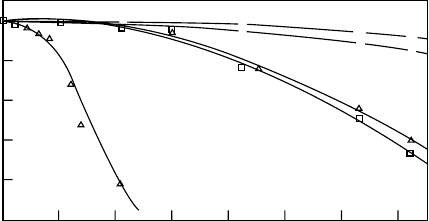
There are a wide variety of processing techniques avail-
able for forming polyanhydrides, however, care must be
taken in incorporating controlled release agents at high
temperatures because of the reactivity of the polymer with
the drug and the instability of the polymer itself. The mech-
anical properties of polyanhydrides are generally poor, tend-
ing to be brittle with minimal fiber-forming abilities.
Forming copolymers of polyanhydrides increases the mech-
anical properties, while maintaining their degradation char-
acteristics [54,55]. Copolymers of methacrylated sebacic
acid (MSA) and 1,6-bis(carboxyphenoxy) hexane (MCPH)
have been shown to have similar mechanical properties of
cortical and trabecular bone [56]. These copolymers de-
grade by surface erosion allowing the scaffold to maintain
its structural integrity [56].
In addition, polyanhydrides have been shown to have
excellent in vivo biocompatibility [57]. The thermal prop-
erties of representative P(CPP-co-SA) copolymers are given
in Table 55.1. A detailed presentation of thermal properties
is given in Domb et al. and Tamada and Langer [48,58].
55.2.5 Poly(3-Hydroxybutyrate) Copolymer
Poly(3-hydroxybutyrate) (PHB) is crystalline, thermo-
plastic polyester made by micro-organisms as an energy
storage molecule (Structure 9). As such, it can be enzymati-
cally degraded by certain bacteria. It is often copolymerized
with hydroxyvaleric acid (Structure 10) to create poly(3-
hydroxybutyrate-co-3-hydroxyvalerate), P(HB-co-HV). Sol-
vent casting has been described from solution in chloroform,
methylene chloride, and tetrahydrofuran [59,60].
The degradation of PHB produces D-3-hydroxy butyric
acid, normally found in human blood, which may contribute
to its low toxicity. There is evidence for both enzymatic and
hydrolytic degradation in vivo [61]. In vitro studies [59, 60]
suggest that PHB and P(HB-co-HV) copolymers degrade by
hydrolysis in a multistage process where the majority of the
molecular weight loss occurs before any significant mass
loss. A graph of weight loss for various P(HB-co-HV)
copolymers is given in Fig. 55.9 [60]. The copolymerization
of hydroxybutyric acid with hydroxyvaleric acid increases
the percentage of amorphous regions compared to PHB,
which are readily attacked by hydrolytic degradation
thereby increasing degradation rates. In addition, elevated
temperatures and alkaline conditions have been shown to
increase degradation rates.
The crystallinity and mechanical properties of the P(HB-
co-HV) copolymer can be varied by modification of the
percentages of the respective monomers. The higher the
percentage of hydroxyvalerate, the less crystalline and
the more elastic the polymer becomes. Some thermal and
mechanical properties are presented in Table 55.1. A study
of thermal characteristics in vivo is given in Gogolewski
et al. [61], and a mechanical evaluation in vivo and in vitro
is found in Miller and Williams [62].
55.2.6 Polyphosphazenes
Polyphosphazenes consist of a backbone of alternating
nitrogen and phosphorus atoms (Structure 11). The R and R’
groups on either side of the phosphorus can be widely varied
depending on the route of synthesis. The choice of func-
tional groups determines the physical and chemical proper-
ties of the polymer [63,64]. Some important types of
polyphosphazenes that have been synthesized are nonhydro-
lyzable, hydrophobic polymers; nonhydrolyzable, hydro-
philic polymers; and hydrolyzable polymers. Those in the
first class include polymers with side fluoroalkoxy, aryloxy,
or organosilicon hybrid groups. These polymers are usually
elastomers with water contact angles on the order of poly
(tetrafluoroethylene) [65]. The second class consists of
polymers with alkylamino, alkylether, alcohol, carboxylic
acid, glyceryl, or glucosyi functionalities. These can be
quite hydrophilic and are often crosslinked to form hydro-
gels. The third class of polymers includes those that can be
hydrolyzed to form phosphate and ammonia derivatives.
Some important side groups include: amino acid esters,
steroidal groups, imidazolyl groups, and other bioactive
molecules. In addition, the surface can also be activated
for use in controlled release.
55.2.7 Fumarate-Based Polymers
The following polyesters are based on fumaric acid, a
naturally occurring substance found in the Krebs cycle [8].
Three types of fumarate-based polymers are discussed:
poly(propylene fumarate) (PPF), poly(propylene fumarate-
co-ethylene glycol) (P(PF-co-EG)), and oligo(poly(ethylene
glycol) fumarate) (OPF).
0
50
60
70
80
90
100
10 20 30 40
Time (d)
% of initial weight
50 60 70
+
+
+
+
x
x
x
x
FIGURE 55.9. Kinetics of percent of initial weight loss for
P(HB-co-HV) copolymers of different copolymer ratios and
molecular weights in the form of solvent-cast disks of 2 cm
diameter and 0.15 mm thickness at 70 8C and pH 7.4. D ¼
10% HV, M
w
¼750,000; I ¼ 20% HV, M
w
¼300,000; C ¼ 12%
HV, M
w
¼170,000; G ¼12% HV, M
w
¼100,000; C ¼20% HV,
M
w
¼ 36,000. (Reprinted with permission from [60].)
SYNTHETIC BIODEGRADABLE POLYMERS FOR MEDICAL APPLICATIONS / 945
Poly(Propylene Fumarate)
Poly(Propylene Fumarate) (PPF) is a linear, unsaturated,
hydrophobic polyester (Structure 12) containing hydrolyz-
able ester bonds along its backbone. PPF is highly viscous at
room temperature and is soluble in chloroform, methylene
chloride, tetrahydrofuran, acetone, alcohol, and ethyl acet-
ate [66]. The double bonds of PPF can form chemical cross-
links with various monomers, such as N-vinyl pyrrolidone,
poly(ethylene glycol)-dimethacrylate, PPF-diacrylate (PPF-
DA), and diethyl fumarate [67,68]. The choice of monomer
and radical initiator directly influence the degradative
and mechanical properties of the crosslinked polymer.
Once crosslinked, PPF forms a solid material with mechan-
ical properties suitable for a range of bone engineering
applications.
PPF crosslinked with either thermal- or photo-initiators
exhibits a biphasic degradation at 37 8C. During the initial
phase of degradation, PPF’s mechanical strength increases,
whereas the mechanical strength diminishes in the second
phase [69,70]. This phenomenon can be explained by the
fact that, at 37 8C, enough energy is provided for the en-
trapped initiators to sustain the crosslinking reaction
[70,71]. To produce a crosslinked polymer of composition
similar to that of the uncrosslinked polyester, diethyl fuma-
rate or a derivative of PPF, PPF-diacrylate (PPF-DA) is used
as a crosslinker [71,72].
Particulate ceramics such as b-tricalcium phosphate
(b-TCP) can also be incorporated within the network to
modify the crosslinked polymer’s mechanical properties
[67]. Hybrid alumoxane nanoparticles can also be incorpor-
ated in PPF to provide mechanical reinforcement [73].
Poly(Propylene Fumarate-co-Ethylene Glycol)
Poly(propylene fumarate-co-ethylene glycol) (P(PF-co-
EG)), (Structure 13), is an amphiphilic block copolymer of
PPF and poly(ethylene glycol) (PEG). P(PF-co-EG) is sol-
uble in toluene, N, N-dimethylformamide, tetrahydrofuran,
and acetone [74]. Similar to PPF, P(PF-co-EG) degrades via
hydrolysis of the ester bonds found along its backbone [74].
Unlike PPF, the crosslinked P(PF-co-EG) forms hydrogels.
Increasing the amount of PEG within the copolymer in-
creases its hydrophilicity, thus encouraging an influx of
water within the network and inducing the material to
swell [75]. Similarly, increasing the concentration and/or
molecular weight of the PPF block reduces the degree of
swelling [75].
The relative amount of the PPF block also affects the
mechanical properties of the crosslinked P(PF-co-EG). PPF
is the only portion of the copolymer that can form covalent
bonds for crosslinking, so more PPF block result in more
possible crosslinks, yielding a stronger material [75]. Add-
itionally the hydrophobic PPF moieties can interact with
each other, forming secondary interactions that further
strengthen the material. A compilation of thermal and mech-
anical properties for P(PF-co-EG) are listed in Table 55.1.
Oligo (Poly(Ethylene Glycol) Fumarate)
The final type of fumarate-based polymer discussed,
oligo (poly(ethylene glycol) fumarate) (OPF) (Structure
14), is a highly hydrophilic, linear, unsaturated polymer,
composed of alternating PEG and fumarate moieties [76].
OPF is soluble in aqueous and organic solvents [76]. Like all
fumarate-based polymers, crosslinking occurs through the
fumarate groups and degradation is mediated by hydrolysis
of the ester bonds. Similar to P(PF-co-EG), the PEG block
gives OPF its hydrophilicity. In addition, OPF’s properties
are controlled by the ratio of fumarate to PEG and the
molecular weight of the PEG. Increasing the molecular
weight of the PEG produces a less crosslinked, and more
swollen hydrogel [76,77]. Moreover, increasing the fuma-
rate to PEG ratio increases the number of crosslinks within
the network and decreases the swelling of the hydrogel [76].
Due to their high hydrophilicity, OPF hydrogels have
been used to encapsulate mesenchymal stem cells for bone
engineering applications [78,79].
55.2.8 Polydioxanones and Polyoxalates
Four important classes of polymers from dioxane-diones
and oxalates are poly(l,4-dioxane-2,5-diones), polyoxalates,
poly(l,3-dioxane-2-one) and poly(l,4-dioxane-2,3-dione),
and poly(p-dioxanone). Representative diagrams are given
in structures 15, 16, 17, and 18, respectively.
The first class has been produced with an alternating
glycolide/lactide sequence. Both PGA and PLA have been
mentioned previously, and the physical properties of the
alternating copolymer are a weighted average of the two
homopolymers.
Secondly, a polyoxalate has been reported [80] with an
ester backbone, which can be hydrolytically cleaved to
produce propylene glycol and oxalic acid. The predicted
degradation rate is faster than PGA owing to its lower
degree of crystallinity and less hydrophobic character.
The third class primarily consists of polymers of 1,3-
dioxane-2-one otherwise known as trimethylene carbonate
(TMC) and its copolymers with glycolide and lactide.
PTMC degrades at a much slower rate than PGA. In
addition, it softens between 40 8C and 60 8C, has low
mechanical strength [5], and is reported to improve handling
properties in copolymers with PGA [4]. Some thermal and
mechanical properties of PTMC are shown in Table 55.1.
Lastly, poly(p-dioxanone) is thought to degrade by a
mechanism similar to PGA [81]. The backbone is hydroly-
tically cleaved in a bulk erosion process with the major
weight loss occurring between weeks 12 and 18 [82]. It
has superior strength characteristics compared to PGA as
well as high crystallinity up to 37%.
946 / CHAPTER 55
